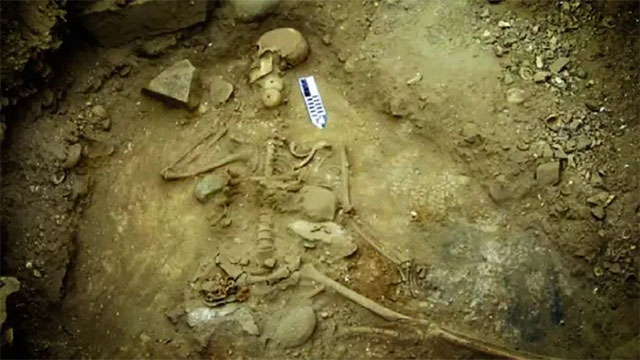Scientists have discovered a human skeleton dating back to the Stone Age found in present-day northern Chile, which belongs to a fisherman who died from drowning.
This is a man who lived about 5,000 years ago and died around the age of 35 to 45. The skeleton was found in a mass burial pit in the coastal region of Copaca near the Atacama Desert, containing four individuals: three adults (two males and one female) and one child.

The skeleton of a Stone Age man recently discovered in Chile.
Researchers reported in April 2022 in the Journal of Archaeological Science that this man was approximately 1.6 meters tall, and his remains showed signs of degenerative diseases and metabolic disorders.
The bones exhibited traces of degenerative joint disease in the back and both elbows; the back of his skull had evidence of healed injuries from blunt force trauma; his teeth and jaw were stained due to tartar, periodontal disease, and abscesses; and lesions in the eye sockets indicated iron deficiency from ingesting a type of parasite found in marine animals.
Other markings on the arm and leg bones suggest repetitive activities related to fishing, such as rowing, fishing, and squatting to harvest shellfish. The researchers proposed that if this individual was a fisherman, he likely drowned.
When forensic teams examine modern skeletons found without accompanying soft tissue, experts can confirm drowning as the cause of death by searching within the larger skeletons for a type of tiny algae, known as diatoms, that live in water and soil environments.
The authors reported that when a person drowns, inhaled water can enter the bloodstream and circulate throughout the body after the lungs rupture, even reaching the “closed system” of the bone marrow through capillaries. Thus, examining diatom species in the bone marrow can reveal whether the individual had ingested saltwater. However, this method has never been used to test ancient bones.
Their SEM scans revealed a particular microorganism. Although no marine material was found adhering to the outside of the bones, the scanning results indicated that the marrow contained numerous tiny oceanic fossils, including algae, parasitic eggs, and broken sponge structures known as spicules. The diversity of marine organisms deep within this man’s bones suggests that he died from drowning in saltwater.
Scientists indicated that the cause of death could have been a natural disaster, as the geological record in the coastal region of Chile holds evidence of powerful tsunamis dating back about 5,000 years. However, with ample evidence from the skeleton indicating that the individual was a fisherman, the more likely explanation is that he died in a fishing accident.
The researchers explained that the damage to the skeleton – missing shoulder joints, cervical vertebrae replaced with shell material, and a broken rib cage – could have occurred when waves struck the body of the drowned man and then washed ashore.
By expanding the scope of modern diatom testing to include a wider variety of tiny marine organisms in their search through the internal cavities of prehistoric bones, co-author James Goff, a visiting professor at the Ocean and Earth Science School at the University of Southampton in the UK, stated: “This could help us better understand the harsh coastal life in prehistoric times – and how the people there were affected by catastrophic events, just like we are today.”















































